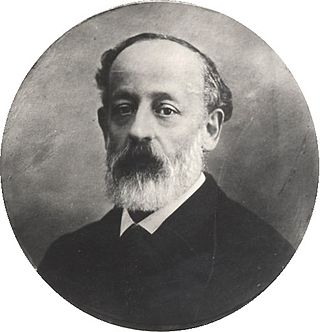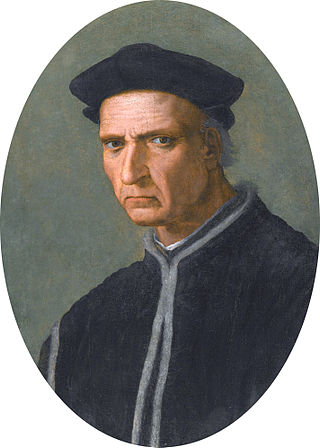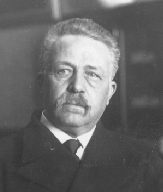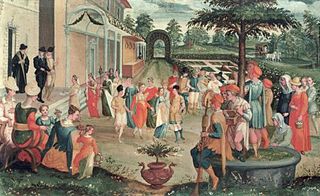This article relies largely or entirely on a single source .(February 2012) |
Gaetano Milanesi (1813-1895) was an Italian scholar and writer on the history of art.
This article relies largely or entirely on a single source .(February 2012) |
Gaetano Milanesi (1813-1895) was an Italian scholar and writer on the history of art.
Milanesi was born at Siena, where he studied law, and in 1838 he obtained an appointment in the public library. [1]
In 1856 he was elected member of the Accademia della Crusca, in which capacity he took part in the compilation of its famous but still unfinished dictionary, and two years later was appointed assistant keeper of the Tuscan archives, in Florence; then he took charge of the famous Medici archives, whence he collected a vast body of material on the history of Italian art, not all of which is yet published. In 1889 he became director of the archives, but retired in 1892, and died three years later. [1]
His most important publication is his edition of Vasari's works in nine volumes, with copious and valuable notes (Florence, 1878 1885). Of his other writings the following may be mentioned:
He also edited a number of Italian classics. [1]

Fra Bartolomeo or Bartolommeo, also known as Bartolommeo di Pagholo, Bartolommeo di San Marco, Paolo di Jacopo del Fattorino, and his original nickname Baccio della Porta, was an Italian Renaissance painter of religious subjects. He spent all his career in Florence until his mid-forties, when he travelled to work in various cities, as far south as Rome. He trained with Cosimo Rosselli and in the 1490s fell under the influence of Savonarola, which led him to become a Dominican friar in 1500, renouncing painting for several years. Typically his paintings are of static groups of figures in subjects such as the Virgin and Child with Saints.

Gaetano Apolline Baldassarre Vestris, French ballet dancer, was born in Florence and made his debut at the opera in 1749.

Pasquale Villari was an Italian historian and politician.

Cesare Cantù was an Italian historian, writer, archivist and politician. An immensely prolific writer, Cantù was one of Italy's best-known and most important Romantic scholars.

Luigi Antonio Lanzi was an Italian art historian and archaeologist. When he died he was buried in the church of the Santa Croce at Florence by the side of Michelangelo.

Sebastiano Conca was an Italian painter.

Piero di Tommaso Soderini, also known as Pier Soderini, was an Italian statesman of the Republic of Florence.

Spinello Aretino was an Italian painter from Arezzo, who was active in Tuscany at the end of the 14th and the first decennium of the 15th century. His style influenced the development of late 14th- and early 15th-century painting in Tuscany.

Count Angelo De Gubernatis, Italian man of letters, was born in Turin and educated there and in Berlin, where he studied philology. He was nominated for the Nobel Prize in Literature fourteen times.

Girolamo Genga was an Italian painter and architect of the late Renaissance, Mannerist style.

The House of Strozzi is the name of an ancient Florentine family, who like their great rivals the Medici family, began in banking before moving into politics. Until its exile from Florence in 1434, the Strozzi family was by far the richest in the city, and was rivaled only by the Medici family, who ultimately took control of the government and ruined the Strozzi both financially and politically. This political and financial competition was the origin of the Strozzi-Medici rivalry. Later, while the Medici ruled Florence, the Strozzi family ruled Siena, which Florence attacked, causing great animosity between the two families. Soon afterward, the Strozzi married into the Medici family, essentially giving the Medici superiority.

Gaetano Mosca was an Italian political scientist, journalist and public servant. He is credited with developing the elite theory and the doctrine of the political class and is one of the three members constituting the Italian school of elitism together with Vilfredo Pareto and Robert Michels.

Cristoforo Rustici, known as il Rusticone, was an Italian painter active in Siena who is known for his religious compositions and allegorical scenes representing the twelve months.

Jacopo di Mino del Pellicciaio was an Italian painter, active in Siena.

Paolo Emiliani Giudici, Italian writer, was born in the small town of Mussomeli, in central Sicily, Italy.

Siena is a city in Tuscany, Italy. It is the capital of the province of Siena. Siena is the 12th largest city in the region by number of inhabitants, with a population of 53,062 as of 2022.
Lorenzo Rustici (1512–1572) was an Italian painter of the Renaissance period, active mainly in his native city of Siena, Italy. He was also known as Il Rustico or Lorenzo di Cristoforo Rustici. His sons were Vincenzo and Cristoforo Rustici. A specific contract for his work in painting the ceiling of the Loggia della Corte de Mercanti in Siena is known. He painted in the church of San Pietro alla Magione in Siena.
Francesco di Bartolommeo Alfei was an Italian painter of the Renaissance, active in Siena. Like other Sienese painters, and different from the contemporary Florentine style, Alfei maintained a gothic and mystical style of painting.
Mino di Graziano (1289–1323) was an Italian painter, active in Siena. He is said to have painted frescoes in the Sala del Consiglio of the Palazzo Pubblico of Siena.

Vincenzo Rustici was an Italian painter active in Siena. He was known for his religious compositions as well as his vedute showing public celebrations in Siena.